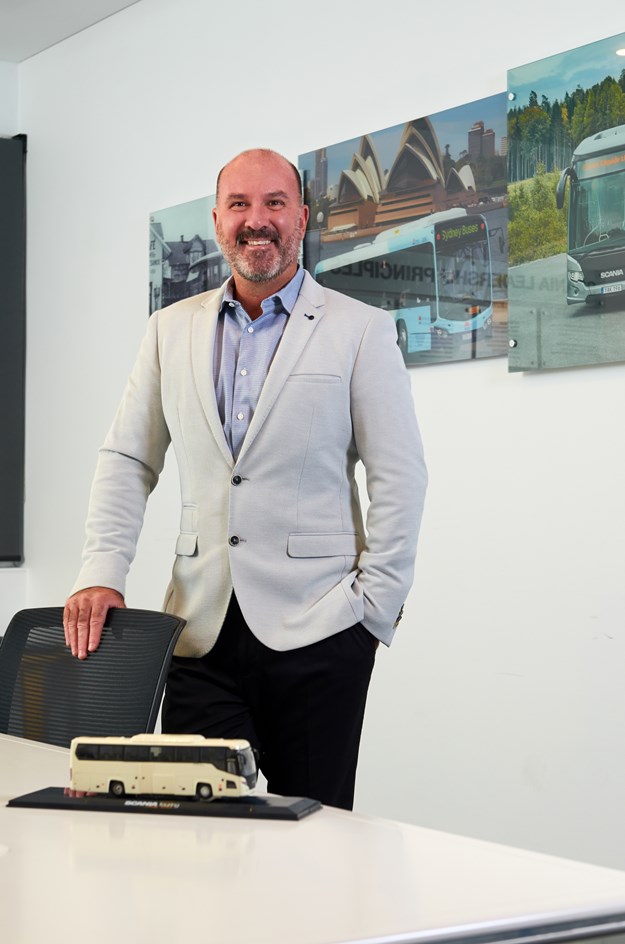INTERVIEW: Previously Scania Australia’s national sales manager for buses and coaches, and now more than two years into his role as sales director for buses and engines, Julian Gurney was gracious enough to have a quick, exclusive chat with ABC magazine regarding where the brand stands now in this region since the Covid pandemic broke. We asked him about how its products and bus business strategy – like a forthcoming new additional Sydney premises and new product at the 2021 Sydney Bus Show – will further facilitate low to zero-emissions transition for operators on various tailored levels, and just how Scania’s emerging technological advancement is better shaping and ‘benchmark pushing’ the overall local and global bus product portfolio. Plus much, much more…
ABC: Hello, Julian. Firstly, well done for making a success for your current role thus far. Has it gone according to plan? How have you best adjusted to any changed dynamics over the past few years and why?
JG: Thanks Fabian, very much appreciate your kind words. It certainly is great to finally catch up with you again as last year was a little ‘tricky’ to plan any travel outside of your home state, so I appreciate the opportunity to update you on what has been happening with the Scania Bus and Coach department these past few years.
In terms of going ‘according to plan’, I’d say that’s a resounding ‘yes’. If I look back at the changing dynamics over the past 12 months or so, the team has done a brilliant job of transitioning to the ‘new way of working’. As we all know, we have had to be respectful of the customers’ needs for CovidSafe interaction with suppliers and therefore virtual meetings have been a good way to say G’day to the bus operators.
Of course, nothing beats personal interaction; it’s one of the main reasons we do what we do as all the team enjoys getting out and about chatting with their customers to see how the businesses are going and what we can do to make sure we continue to support them the best we can.
For me personally, the addition of the engine sales portfolio has meant that I have had the opportunity to learn about a whole new area of the business and, disappointingly, still waiting to go on a sea trial on some of the new Maritimo luxury pleasure boats that we are fitting our Scania engines to – but I am sure I’ll get a chance some stage this year!
ABC: What is the current Scania Australia executive hierarchy and how does that best meet the needs of the corporation from a global perspective to the benefit of its local bus customers, and why?
JG: Scania Australia is very lucky to have Mikael Jansson at the helm. Mikael is extremely invested in the bus business and has attended every BIC conference since his arrival in 2017, further demonstrating his commitment and that of Scania Australia to the local bus industry. He is extremely passionate about driving our industry towards a greener and more sustainable future.
As the sales director, I report in directly to Mikael, and, under me, I have the benefit of a team of bus industry stalwarts across product development, sales and aftersales – many of whom have three or more decades of experience in the bus industry. In fact, there’s well in excess of 200 years of local bus industry experience in this group alone!
Even more beneficial, this experience is spread across our nine company-owned branches Australia-wide. We believe in supporting our customers all the way from the factory to their door, using Scania Australia staff. With our very flat lines of communication, we’re able to deliver exceptional levels of uptime and customer satisfaction.
In a few months, we’ll open a second company-owned sales and service location in Sydney at Eastern Creek – further demonstration of our financial commitment to the continued expansion of our service network.
ABC: What have you uniquely brought to this role that seems to be a natural mix for you to achieve any personal objectives and goals that you’d set? How has this role helped you evolve as a person? What have you learned about yourself that you may not have acknowledged or focused on previously?
JG: I am focused on achieving the results we set each year as agreed to by the team and I have also set my own personal challenges for this role. The 2019 sales volume was a highlight not only for me, but also my whole team.
Having the team interact closely with each other, as well as the other stakeholders within the business, is very satisfying and a goal we strive for each year. I’m also focused on empowering the members of my team, to give them confidence around their decision making and to back them when they have to make the hard calls. These positive attitudes forge resilience, confidence and delivers success from both a business and personal perspective.
Personally, I’m keen to further enhance the way the Scania Brand and the Scania Bus and Coach Team are perceived within the industry and, critically, how much our account managers enjoy doing what they do. By supporting the account managers who are out on the road – often for quite a long time away from their families – to be successful in their efforts is a great reward both personally and professionally for me.
Transitioning from an account manager eight years ago to a sales director working with senior management in a Scandinavian company has taught me a lot when it comes to interpersonal interaction within the company across all levels. Being respectful to the people you work with, following the Scania core values as a way of working, and ‘listening’ rather than ‘telling’ when it comes to solving various issues with internal stakeholders, has been the biggest evolution for me as a manager. It’s still a work in progress, and you never stop learning, but I hope that I am heading in the right direction.
ABC: So, let’s talk about pre- and post-pandemic. End of 2019 Scania had eclipsed its previous high of 403 units, reaching a record 427 bus and coach deliveries (new vehicles commissioned). Few companies would have been looking to duplicate such results during the nightmare of 2020, but as we hit the first quarter of 2021, how are things looking for a solid to positive end of year result? And if so, what adjustment of strategy or changed forward thinking has Scania Australia to implement to ensure such a result?
JG: Talk about the highs and lows! We are very grateful to our customers who supported us to achieve the record volume of deliveries for Scania in 2019.
You are 100 per cent spot-on when it comes to having to do a ‘re-adjustment’ of the previous numbers that were forecast at the start of 2020, as to what we are looking to achieve volume-wise for 2021.
Market conditions have meant we’ve had to review our ‘sales ambition’ for 2021, and the factory understands and fully supports our revised strategy.
The city and school bus markets are still running at a fairly good pace in terms of overall volume; the opportunity sales for charter coaches (two- and three-axle) have definitely been affected by the lack of activity when it comes to local and international tourism and travel.
If we look at the level of customer support in this segment, Scania implemented a series of initiatives to support our customers who have been affected by the downturn. We took these decisive steps to release some of our operators from their commitments on coaches that were built, but which they couldn’t afford to take delivery of.
We created a series of innovative, flexible arrangements for customers in good standing who found themselves in difficulties not of their own making, when it came to their repair & maintenance contract and finance contract payments.
Just like the federal government, we appreciated the unprecedented nature of the Covid emergency, and we wanted to ensure these (largely family) businesses would have the best chance to survive and become active customers again after the crisis was resolved.
Our goal for 2021 is to maintain the best level of support we can for our clients and, for me as a manager, I want to make sure the team understands that the numbers will be lower than 2019 – and as a company we have set a realistic expectation that reflects the change in the dynamics of the market.
ABC: The last time we really had a good chat with you, the fully integrated Scania Touring coach had been launched and, since then, we’ve reported on operators like Victoria’s Ventura having picked up eight units for its fleet – and these with a luggage space-saving slide-out wheelchair lift. How has the Touring roll-out gone thus far and to what extent did the impact to Australia’s coach tourism sector play in the overall result? Not just in terms of expected and actual units delivered, but any supply issues that needed to be overcome from China?
JG: The Scania Touring has really hit its stride since the launch, and its acceptance amongst the operators has been fantastic.
Off the back of the initial order from Ventura we are delivering another 13 units to them this year and the Dineen Group (among others) are also big advocates of the Scania Touring. Nothing like having a 9.3-litre, 360hp (268kW) engine with 9 cubic metres of luggage space!
We are fortunate that the supply of the Scania Touring wasn’t impacted by Covid. Our team of Scania and Higer personnel at the factory in Suzhou, China, kept us up to speed with how the vehicles were progressing and, as mentioned, we are rolling out deliveries of these as we speak. The addition of the wheelchair option has been welcomed by the operators who are looking to make sure they meet DDA compliance or use them for the contracts where the wheel chair-lifters are required.
ABC: Good news recently about some key operators picking up the new Euro 6 Scania hybrids, such as Adelaide metro in South Australia spec’ing one up with Precision/Bustech bodies for O-Bahn busway use and Melbourne-based Ventura Bus Lines taking delivery of its first two Scania hybrid route buses, fitted with locally-built Volgren bodies .
Is the take-up of hybrid tech in general still matching expectations or has it been better or worse than anticipated to whatever timeframes had been factored in for this region? Or is it finding unexpected favour amongst operators given a cautious low-emissions transition outlook here? What has been the feedback thus far they’ve given to Scania’s product researchers?
JG: If we take a quick look around the country, there are different requirements from all the state governments when it comes to their policies around the transition to low or zero-emission buses.
The take-up of hybrid tech as a transition to zero-emission bus technology (either battery or hydrogen-based technology) is a solution that most European OEMs can provide ‘here and now’.
The operators’ interest in hybrid technology definitely still remains high, as hybrid technology is the perfect option for operators (both metro and regional city buses) looking for a product that reduces their carbon footprint, but without the necessary infrastructure and other costs involved with moving to full battery electric vehicles (BEVs).
The learnings from the Scania hybrid buses that are in operation in Australia and around the globe have been a great source of information, and one on which the BEV program has been based. The more we know about the demands on the battery (capacity, state of charge, charging cycles, beginning-of-life/end-of-life final charge status, etc.) the better the product will be once we introduce it into the Australian market.
ABC: We keep hearing about telematics ‘geo-fencing’ technology in Europe, which is in its infancy if at all here in this region. What is Scania doing to tap into the market here with that and what are the implications for the wider bus community if and when it gains more acceptance and implementation? What is it about Scania’s delivery of such tech that uniquely benefits both Scania’s and operators’ common objective as a whole? That is, if you had to explain it in layman’s terms to potential users of it – why should they be looking into it at all?
JG: Geo-fencing and the functions and features are a part of the Scania Zone package that is available in the New Bus Generation (NBG) that we will be launching at the Sydney Bus Show.
It offers the ability to remotely and automatically regulate the vehicle speed (for diesel vehicles) and with our Next Gen plug-in hybrids we can also use it to trigger the silent mode and zero tailpipe emission modes as the vehicle passes through a predetermined area, delivering less noise and emissions in the more densely populated zones, such as the CBD. As we know, hybrids have the capacity to offer a solution ‘here and now’ when it comes to transitioning to low-emission vehicles.
The Scania Zone concept is not backwards compatible to our current product range in Australia, so we will look at its introduction with the new generation of products due very soon. We know there are operators who would like to have these features, and so we will look to offer them as soon as we can. Unlike Europe, however, Australia has no low-emission or zero-emission zones as yet.
ABC: Scania fully electric buses for Oz – talk to me. What kind of timeframe are we looking at – the next three months, the next four years, or have changed global markets dictated that for here the focus should still be on hybrid new products for longer? What boxes still need to be ticked before Australian Scania fans get to slip their backsides into seats attached to a bus body that’s connected to a Scania e-chassis?
JG: As a sales director, I look at what products are available from the factory and, of these, what will work best for our market. Here and now, our offer is hybrid technology, mixing diesel or biodiesel with an electric motor. It’s an option that makes commercial sense and delivers a tangible environmental bonus.
Just like us, our customers are focused on a commercially sustainable transport solution. At present, hybrid is the most logical way to reduce CO2 emissions. We’ll be meeting our science based targets using hybrids, reducing our CO2 footprint, and from a well-to-wheel standpoint, our hybrids score better than battery electric only power when the electricity is generated by coal-fired power, which is something we tend to forget in our race to put BEVs into our public transport system.
“That’s not to say we are not asking our product planners in Sweden for BEV chassis. We have and they are working on it. But it will not be an overnight solution. We will look to test and drive a BEV product in Australia soon as a precursor to a product roll-out over the next few years, but in addition to ensuring the product is right for our market, we need to ensure this makes commercial sense for Scania and for our customers – not only in the up-front costing, but whole-of-life and disposal costings as well. Our approach ensures environmental and commercial sustainability. We don’t believe you need to compromise one objective to achieve the other.
ABC: What are your views on alternative fuels for buses? How have any changes in fuels and bus propulsion methods affected bus building, in terms of design and materials, if at all? Is hydrogen stored in bus roofs an issue in terms of materials to prevent or contain potential fires? And if not fuel-cell in coaches, any application of the Scania Europe LNG gas tech making it here ever?
JG: Our message on alternative fuel buses has been very consistent over the years as we know there is no ‘silver bullet’ when it comes to reducing our carbon footprint across the globe.
Scania has another 100-plus CNG buses being built for a European client with Castrosua bodies and, as you mentioned, LNG buses operating in Europe and ethanol buses operating in India. All of our Euro 6 buses that come into Australia are factory prepared to be able to run on bio-diesel, should our clients ever wish to take up this option. Bio-diesel can make a significant contribution to the reduction in operational CO2 emissions.
Our challenge locally is the lack of any alternative fuel rebates or incentives from our federal government. We are working with DTMR/Translink in QLD to put two bio-ethanol buses into operation in Mackay. Fuel will be sourced from the Wilmar bio-ethanol plant in Sarina. The project is supported by the Department of State Development, Tourism and Innovation’s Queensland Biofutures.
If we look at the technology around hydrogen storage today versus the CNG tanks of the early 2000s, it is a vastly different type of tech. The use of hydrogen for zero-emission buses is currently limited, as three times as much renewable electricity is needed to power a hydrogen bus compared to a battery electric bus. A great deal of energy is lost in the production, distribution, and conversion back to electricity.
However, hydrogen is a promising energy carrier and a good way of storing energy over long cycles. It will also play an important role in decarbonisation if we are able to produce it in an environmentally friendly way (i.e. not with electricity generated from fossil fuel).
ABC: Are there any major Scania news for this region coming up we should know about – early? Anything even you could to allude to so Scania fans get their bus fix? 🙂
JG: :On top of the launch of the New Bus Generation that we will have on display at the Sydney Bus Show, one exciting piece of news is that we are working very closely with one of our international body building partners on a hybrid school/charter bus.
The lack of infrastructure in our smaller regional towns to support BEVs for regional school/charter operators has meant that there is a gap when it comes to reducing the overall CO2 footprint for bus operators in this sector. We are still in development phase, but our aim is to have this product ready for 2022 sales opportunities.
ABC: Any developments in terms of Scania driverless bus tech? And if so, and it gets here someday, what is planned to replace the legendary Scania Best Bus Driver competition that you guys used to run? Just sayin’… 😉
JG: That’s an easy one! Yes, we are still working on autonomous vehicles for both truck and bus, but as we know this is a highly complex area that involves incredible technology, solid and reliable communications systems, as well as the questions around the legislation requirements for the operation of these types of vehicles.
The Scania Best Bus Driver Competition is something we all miss, and once we can safely run these types of competitions again I am sure the applications will come flooding in!
ABC: Does Scania have any region-friendly double-decker or articulated product that we should know about, particularly from an e-bus perspective? If so, what are the chances that Scania would bring such tech and product here?
JG: The double-deckers seen in operation overseas are based on our two-axle Scania KUD chassis that is operating in Europe, and restricted to markets that allow in excess of 18 tonne GVM for a two-axle chassis. We cannot operate these here legally. For articulated buses, the area of focus is on the high volume rigid 4X2 chassis platform, with articulated e-buses slated for 2024 production. Watch this space!
ABC: Personally, do you ever find your passion and drive for buses waning, or is it only getting more intensified for some reason? What is it that drives you each day to provide better bus product – and why?
JG: Definitely the latter! The changes in technology in the bus industry has brought about a whole new set of challenges for all OEMs, especially the European-based ones, as it is fair to say the competition from China is leading the charge when it comes to global sales volumes of BEVs.
While the traditional model of supplying a diesel-fuelled bus to our customers is still a large part of our business, the various state governments’ focus on the transition to zero-emission buses has meant that we are now running almost two businesses side-by-side: Keeping on top of our clients’ current demands for reliable diesel buses on the one hand, while working out what will be the best product to meet the future needs of low/zero-emission technology. It certainly keeps the juices flowing.
Many people may not know that my background is in environmental science (yep – a science graduate nerd!), so anything to do with reduction in CO2 footprint is close to my heart. Scania as an organisation has embraced ‘sustainable transport solutions’ as its mantra, which is now hard-wired into our DNA. Providing ‘a better bus product’ that will see a reduction in overall emissions produced by our industry remains a key driver for me, and is one about which I am very passionate.
ABC: Jules, thanks so much for your time. Any final words or thoughts for Scania bus fans in Australia?
JG: It’s been great to give you and the industry an insight into what is happening in ‘Scania Land’. I know the Scania bus business is very excited about the opportunities we have with the Scania hybrids as we transition to zero-emission buses. The launch of the New Bus Generation at the Sydney Bus Show with the new-look dash and electrical platform is going to be a fantastic addition to our product line-up, especially for those clients who wish to take on board the new safety system features such as ADAS (advanced driver assistance system) with integrated vulnerable road-user detection systems. But more about that later in the year.
Finally, on behalf of myself and all the team at Scania, a big shout out goes to all the operators and their staff for doing such a fantastic job keeping the schools and public transport routes operating throughout the past 12 months or so. We know you have stared down immense challenges. It’s been a mighty effort and one we need to recognise as an industry just how well and how safe the movement of millions of passengers has been during the Covid crisis. It’s something about which we as an industry can be very proud.
TRIVIAL PURSUIT
1. SONG STUCK IN YOUR HEAD RIGHT NOW…
Zombie (sorry, bad dad joke!).
2. LAST GREAT PLACE YOU VISITED…
Fraser Island – more amazing than all the photos and 4WD videos portray it to be.
3. A FAVOURITE DISH…
All Thai or Vietnamese food!
4. A FAVOURITE DRINK…
If we are talking alcoholic then you can’t beat a pot of Carlton Draught straight from the beer tap!
5. IF YOU COULD CHANGE THE WORLD YOU WOULD…
Have fossil-free electricity tomorrow.
6. SOMETHING THAT YOU LEARNED ABOUT YOURSELF TODAY…
…Is that there is always something new to learn every day, you should never stop being curious!
7. THE ONE THING YOU CAN’T LIVE WITHOUT IS…
Family!
8. YOUR MOST EMBARRASING MOMENT IS…
Breaking my ankle gardening and having to get my wife to drag me, half crawling on one knee, out of our back yard and to take me to hospital. Going to be a while before I live that one down.
Photography: coutresy Scania Australia



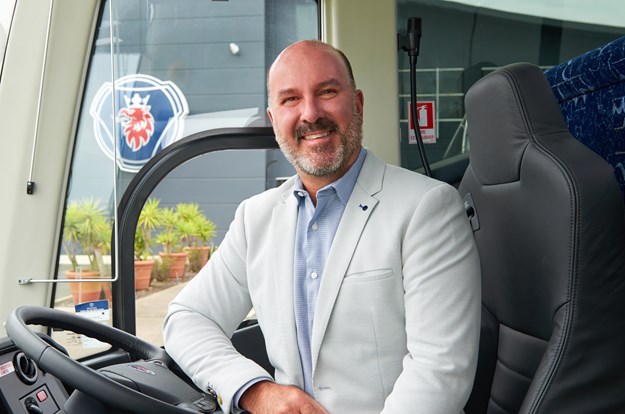
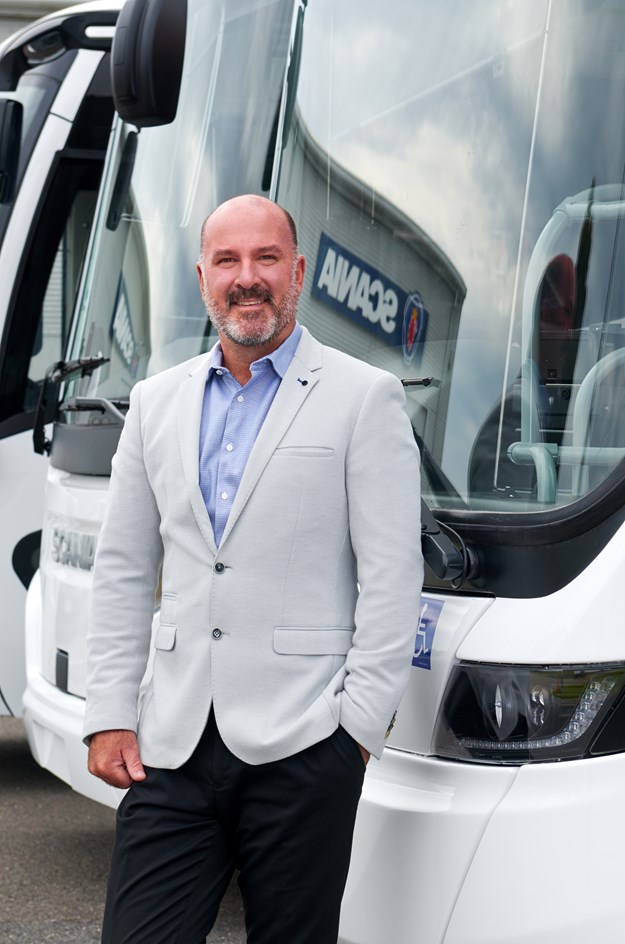
.jpg)
.png)
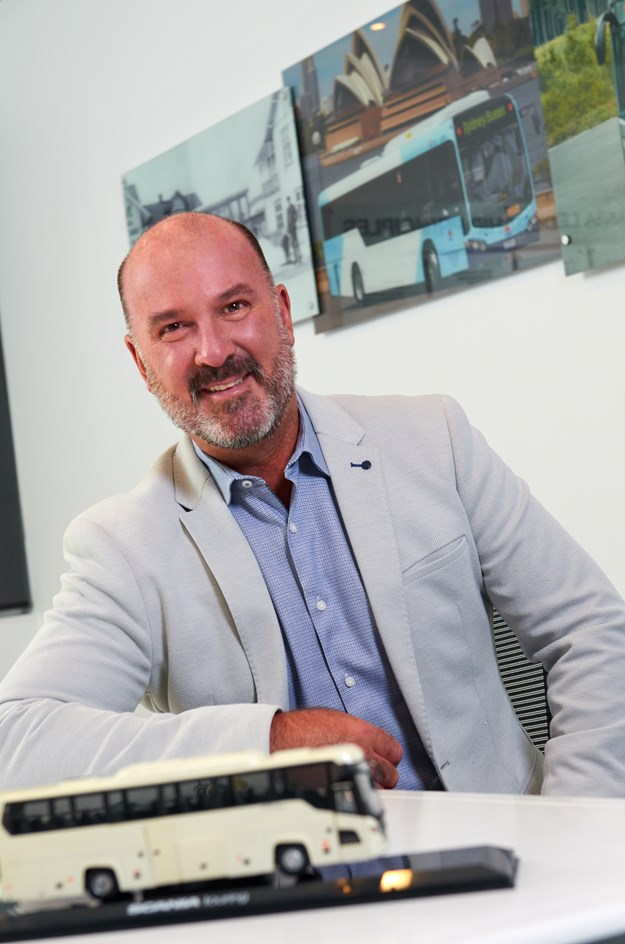
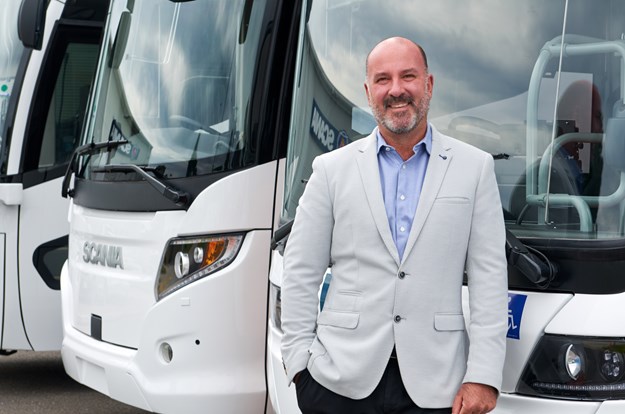
.jpg)

.jpg)
